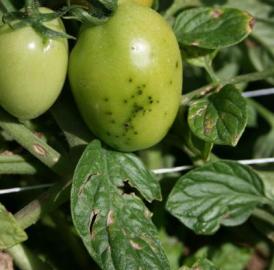"We know that microbes can disguise themselves by altering the proteins or molecules that the plant uses to recognize the bacteria, as a strategy for evading detection," said Peck, associate professor of biochemistry at the University of Missouri and lead author of the PNAS paper. "Our results now show that the plant can also disguise itself from pathogen recognition by removing the signals needed by the pathogen to become fully virulent."
The research carried out examines a key moment in the relationship between microbe and host, when a microbe recognizes a host as a potential target and employs its molecular machinery to pierce it, injecting its contents into the plant's cells — a crucial step in infecting an organism.While Peck's study focused on bacteria known mostly for damaging tomatoes, the findings also could have implications for people. The same molecular machinery employed by Pseudomonas syringae is also used by a host of microbes to cause diseases that afflict people, including salmonella, the plague, respiratory disease, and chlamydia.
The work focused on bacteria known as Pseudomonas syringae pv. tomato DC3000, which can ruin tomatoes as well as Arabidopsis. The bacteria employ a molecular system known as the Type 3 Secretion System, or T3SS, to infect plants. In tomatoes, the infection leads to unsightly brown spots.
Peck's team at the University of Missouri had discovered a mutant type of the plant, known as Arabidopsis mkp1, which is resistant to infection by Pseudomonas syringae. The Missouri and PNNL groups compared levels of metabolites in Arabidopsis to those in the mutant mkp1 form of the plant. Peck's group used those findings as a guide to find the compounds that had the biggest effect — a combination that invites infection.
The researchers discovered a group of five acids that collectively had the biggest effect on turning on the bacteria's T3SS
- pyroglutamic,
- citric
- shikimic
- 4-hydroxybenzoic
- aspartic acids.
While Peck's study focused on bacteria known mostly for damaging tomatoes, the findings also could have implications for people. The same molecular machinery employed by Pseudomonas syringae is also used by a host of microbes to cause diseases that afflict people, including salmonella, the plague, respiratory disease, and chlamydia.
While Peck's study focused on bacteria known mostly for damaging tomatoes, the findings also could have implications for people. The same molecular machinery employed by Pseudomonas syringae is also used by a host of microbes to cause diseases that afflict people, including salmonella, the plague, respiratory disease, and chlamydia.
The work opens the door to new ways to rendering harmful bacteria harmless, by modifying plants so they don't become invasive.






No comments